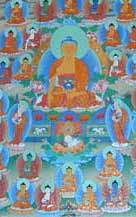



On Dec. 11, exactly three months after the tragedies at the World Trade Center and the Pentagon, 20 Tibetan Buddhist monks from Drepung Loseling Monastery in India will begin constructing a special mandala sand painting to heal and protect America at the Smithsonian's George Gustav Heye Center of the National Museum of the American Indian at the Alexander Hamilton U.S. Customs House, One Bowling Green, in New York City. One of the largest sand paintings ever created in the West, this 7-foot-by-7-foot mandala will be constructed between Dec. 11 and Dec. 23.
Immediately after the Sept. 11 tragedies in New York City and Washington, D.C., His Holiness the Dalai Lama called for Tibetans throughout the world to show solidarity with America in this time of crisis and grief.
According to Geshe Lobsang Tenzin, representative of Drepung Loseling Monastery in North America, the mandala sand painting is a sacred cosmogram representing the world in perfect harmony. For centuries the Tibetans have relied upon mandalas and accompanying prayer ceremonies for healing and protection in times of tragedy and crisis.
Following the New York event, the monks, who are traveling as part of the Mystical Arts of Tibet Tours for World Healing, will go to Washington, D.C., to build a similar sand mandala at the Smithsonian's Arthur M. Sackler Gallery, Jan. 11 - 27, 2002.
"This is a wonderful opportunity for New Yorkers and all Americans," said John Haworth, director of the George Gustav Heye Center. "All of us at our museum, which is only a few blocks from ground zero, have borne witness to the suffering and devastation. We are indeed pleased to be the New York venue for an event to help ease the pain and anguish of Sept. 11."
The mandala sand painting begins with an opening ceremony on Dec. 11 at noon, during which the monks consecrate the site and invoke healing forces through chanting, music and mantra recitation. To create this mandala, the monks will draw a formal pattern on the base, using traditional iconography that includes intricate geometric shapes and a multitude of ancient spiritual symbols. The monks then painstakingly place millions of grains of brightly colored sand to form the mandala. The mandala represents the world in its divine form, as well as a meditational tool for effecting healing and protection on inner and outer levels.
The completion of the mandala on Dec. 23 will be marked by a closing ceremony. The mandala then will be dismantled; the sand will be swept away, placed in an urn, and taken to the river, where it will be poured into the water. The river will then carry the healing energies throughout the world.
This special event is presented by the Smithsonian Institution, the Drepung Loseling Monastery and Richard Gere Productions. It is co-sponsored by the Office of Tibet in New York, the Tibet Fund, Jewel Heart, and The New York and New Jersey Tibet Association. For more information about the exhibit visit www.mysticalartsoftibet.org
The George Gustav Heye Center is located at the foot of Broadway in lower Manhattan at One Bowling Green. Admission is free. Hours are 10 a.m. to 5 p.m., except Christmas Day. The museum is open on Thursday nights until 8 p.m., courtesy of the Booth Ferris Foundation. For more information about the Smithsonian's National Museum of the American Indian, visit www.conexus.si.edu